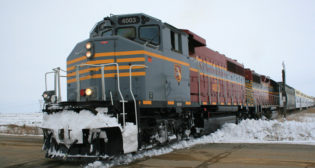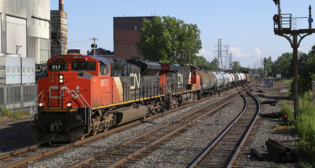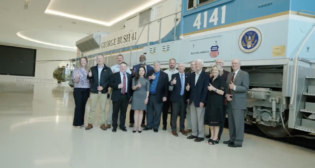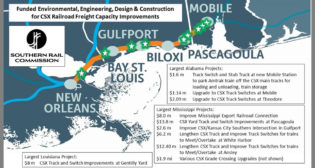Freight car market headed for new growth in 2014
Written by
William C. Vantuono, Editor-in-Chief
Economic Planning Associates, in its quarterly freight car building forecast released Monday, July 29, expects this year’s numbers, which are lagging about 11% behind 2012’s, to improve significantly in 2014. “Based on first-half assemblies and mid-year backlogs, we look for deliveries of 52,500 railcars this year, a 10.8% decline from the 2012 level,” EPA’s Peter Toja said. “Next year, we look for a rebound to 60,300 deliveries as our economy shows somewhat stronger growth and some aging equipment is replaced.”
Looking ahead through the next four years, Toja predicted that, beginning in 2015, annual railcar assemblies will be relatively consistent, “staying in the narrow range of 64,300 to 65,500 cars and intermodal platforms out to the year 2018.”
Though orders placed in 2013’s second quarter moderated from the first quarter, Toja optimistically noted that demand for railcars has broadened, with regard to car types. “In the first quarter, tank cars accounted for 80.6% of the total orders,” he said. “In the second quarter, tank cars comprised only 46.8% of the total orders as demand picked up for boxcars, mid-sized covered hoppers, small-cube covered hoppers, and intermodal platforms.”
However, Toja noted, “we are still cognizant of the fact that tank cars currently comprise 83.2% of the backlogs, and our struggling economy might dampen future growth in the other car types. At the current rate of assemblies, the tank car backlog of 61,350 units represents almost nine quarters of production. And, with the railroads making significant investments in facilities and equipment to accommodate the rapid expansion of oil production, we expect tank car demand to remain on a high note for the foreseeable future.”
With regard to other car types, “we continue to be concerned about the underwhelming growth of the economy as manufacturers, oil and gas producers, and coal companies struggle with the increasing number of government regulations that are dampening our economic potential,” Toja said. “We have noticed our GDP growth in the first quarter was revised down from 2.5% to 1.8%. Hopefully, our economy can eventually embark on a stronger path of growth that will improve railroad traffic, revenue, and investments, leading to continued healthy growth in railcar demand.
“From this point on, we look for some stabilizing in demand for boxcars and grain cars, along with a pickup in demand for small-cube covered hoppers, stronger growth in intermodal equipment, and continued rapid expansion in tank car demand. At the same time, the easing in manufacturing output and demand for steel will subdue any growth in mill gondolas and steel coil cars.
“Coal cars continue to be plagued by stringent EPA standards and are certain to experience a weak 2013 before showing signs of a modest improvement in 2014. After 6,492 coal cars were assembled last year, we look for deliveries of only 2,250 units this year.
“In spite of declines in agricultural products and coal, the Class I railroads reported strong revenues and profits in the second quarter. The roads also continue to make investments in track, facilities, and equipment. The solid income base of the railroads should serve to support railcar demand in the years to come. Nonetheless, the extremely weak grain and coal environments in 2012 offset strong growth in segments such as petroleum, motor vehicles, aggregates, and lumber. Due to the large volume of coal and grain movements relative to total commodity haulings, rail commodity movements dropped 3.1% last year. Nonetheless, the railroads are continuing strong capital spending plans for 2013 as they prepare for continued growth in oil, chemical, light vehicle, and intermodal movements.
“The investments will be well-founded as we witness future growth in these categories. At the same time, after an extremely weak first quarter of 2013, coal movements improved dramatically in the second quarter, and should continue a modest growth path during the second quarter. The USDA is projecting strong production and exports for a variety of grains in marketing year 2013/2014, which should boost demand for grain and fertilizer cars. As a result, we expect only a 0.2% decline in commodity haulings this year, followed by a 2.6% rebound in 2014.
“In spite of continued investments by the railroads, 2013 will be a difficult year for carbuilders. With the exception of tank cars, which will experience explosive growth in assemblies this year, most other car types will see moderation or declines in deliveries as our economy struggles.
“In the light vehicle sector, we are already noting the moderation in North American production. Last year, U.S. assemblies of light vehicles were 19.0% above 2011, while Canadian production advanced 15.3% and Mexican output expanded 12.3%. However, through June of this year, U.S. auto production increased only 5.4%, Canadian output declined 6.8%, and Mexican assemblies were up 4.4%. And, automotive haulings are reflecting the moderation in North American production. In the first half, rail movements of motor vehicles and parts were up only 3.7%. This will dampen growth for autorack carriers and auto service box cars as we proceed through 2013. We look for only moderate quarterly advances in factory output through 2013 and into 2014.
“Consumer spending will be sluggish, the job markets are weak, confidence has dropped, and consumers are looking to improve their balance sheets, rather than purchase more products. The export markets have slowed considerably over the past year and we expect further weakening in 2013, before there is some bounce-back in global economic activities in 2014.
“The steel markets are reflecting the slowing in industrial activities. According to the American Iron and Steel Institute, domestic steel shipments through May were running 6.0% below the previous year, while steel imports were 3.7% lower in the first five months. This will dampen demand for GB gondolas this year.
“Grain loadings tumbled 9.5% last year, as the severe drought took its toll on grain production. And, based on data and information from the USDA, we expect further weakness in grain haulings this year. Domestic markets will be relatively flat while the export markets for corn and soybeans will be softer than last year. In this year’s first half, carloadings of grain were running 17.2% below last year. Hopefully, more moderate weather during the remainder of this year will help minimize the decline in haulings and lead to a rebound in 2014. However, we currently expect a 9.0% decline in rail grain movements this year and a modest 1.6% rebound in 2014. As such, we look for grain car assemblies to moderate this year before resuming a growth trend beginning in 2014.”
Longer term, Toja “is hopeful that stronger economic activities will provide support for certain railcar assemblies while an improvement in the financial environment, high gasoline prices, and strong government backing stimulate greater demand for ethanol and DDG cars. Replacement pressures and technological advances as well as legislative measures will also play a role in promoting the demand for a variety of railcars. Construction activities are expected to continue to advance, which should support movements of aggregates and structural steel products. Continued expansion in demand for crude oil, petroleum products, chemicals, and food and beverages will prop up the haulings of a variety of liquid products and the demand for tank cars.
“Stricter air emission standards will promote the use of lower sulphur western coal, which should lead to some limited replacements of older, smaller, steel-bodied coal cars with the larger volume aluminum gondolas and hoppers of today and tomorrow. At the same time, eastern coal fleet requirements will stimulate some demand for technologically advanced steel and hybrid coal cars.
“Growing worldwide nutritional needs and expanding exports will pressure the current grain service cars as we proceed through the longer term while long-neglected segments such as equipment to haul waste, aggregates, and limestone show signs of revival and should add to the railcar delivery mix in the years to come. However, the most dynamic element in the long term rail car environment will be tank cars to transport ever increasing volumes of oil and petroleum products.”




